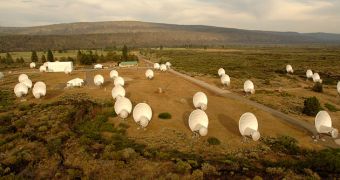A new SETI tool in the search for intelligent alien lifeforms has been built. It is called the Allen Telescope Array (ATA) and it has recently been powered up in its first stage configuration of 42 antennas. When complete, in 2025, it will feature the combined power of 350 such dishes. The project, financed by Paul Allen, co-founder of the Microsoft corporation, will do the same thing as its parent institution, namely it will seek out ET's home.
Following the successful test of detecting the New Horizons probe which is on a course that will take it towards Pluto and beyond, experts like senior SETI scientist Seth Shostak prove very confident. "We'll find E.T. within two dozen years," stated Shostak, quoted by UniverseToday, if Moore's law still proves to be correct (the number and the capabilities of transistors on an integrated circuit roughly double every two years) and technology maintains its progressing pace.
Combining the power of the 350 antennas will allow us to look about 500 light years far into space, which, judging by Frank Drake's famous formula, should be more than enough to find intelligent aliens. The formula gives a very rough estimate of the number of planets that could house intelligent civilizations that we could contact (or be contacted by) – there are 10,000 of them. It is not difficult to understand, if you don't pass out at the sight of the complicated-looking numbers. Here it is:
N = R* x fp x ne x fl x fi x fc x L
where:
N is the number of civilizations in our galaxy with which we would be able to communicate;
and
R* is the average rate of suitable stars' (Sun-like) formation in our galaxy; fp indicates the amount of those stars that have planets; ne is the average number of worlds that can potentially support life per planetary system; fℓ is the fraction of the above where life actually develops at some point; fi is the amount from the above where intelligent life occurs; fc is the fraction of civilizations that develop a technology that releases detectable signs of their existence into space; L is the length of time such civilizations release detectable signals into space.Many experts believe another constant should be added to the equation, representing the possibility that our communication systems are actually compatible with theirs, namely if we came across a signal or whatever it is that they use for communication purposes, we would be able to effectively acknowledge it and interpret it as such.

 14 DAY TRIAL //
14 DAY TRIAL //